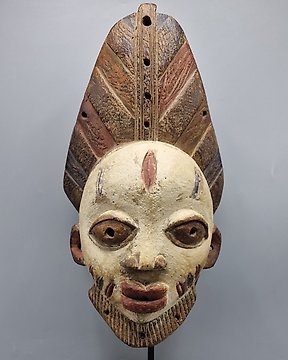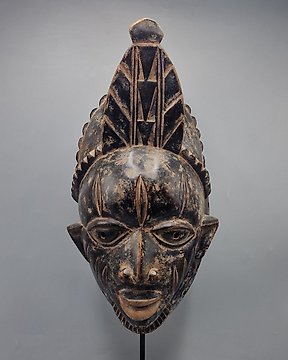Păpușa Ibeji - Yoruba - Nigeria (Fără preț de rezervă)
Nr. 84040893

Shango - Yoruba - Nigeria (Fără preț de rezervă)
Nr. 84040893

Shango - Yoruba - Nigeria (Fără preț de rezervă)
A Yoruba Shango staff, rising from a slender cylindrical staff, the figure is in the shape of a woman standing straight, her hands on her thighs, her head looking forward composed of camling features, two wide eyes, and incised paralelle scarification lines, wearing her large double axe headdressremnants; the figures is covered with remants od blueish pigments.
"The elegance of this oshe Shango immediately captures our attention." John Pemberton III
Among the Yoruba people of southwestern Nigeria, Shango is a widely celebrated deity, orisha. At the time of the god's annual festival or when offering weekly prayers and sacrifices at a household shrine, devotees will grasp an oshe Shango, a dance wand for their Lord, and chant an oriki, a praise song, such as:
Oba Koso. I hope you awakened happily. Ooooo!
My Lord, save me from trouble. Oooo!
Did you awaken happily?
You have fire in your mouth, fire in your eyes,
and scorch the metal roof tops.
Shango dance wands are distinctive in their design. The vast majority have the shape of a double headed axe. Many appear to have two stone celts jutting from the head of the central figure depicted on the handle of the dance wand. The figure is usually a standing, kneeling, or seated female figure holding an offering bowl or the lead of a ram, Shango's favorite food. She will often have a child on her back or twin children, ibeji, standing at her side. She maybe lifting her breasts in a gesture of greeting or hold an oshe as a sign of her devotion. As in all Yoruba ritual art, an oshe Shango images the nature of the deity and of the devotee.
In Yoruba legends, itan, Shango is said to have been the fourth oba, ruler, of the Oyo Empire. The stories about him are legion. They focus upon his success as a political and military leader and yet his lust for power beyond the appropriate limits of political authority. In one story it is said that he was fascinated with magical powers and inadvertently created storms filled with terrifying thunder and lightning bringing ruin upon his palace, family and the houses of town's people. In shame, he left the capital city and committed suicide by hanging himself in a town called Koso. When the storms continued after his death, many of his former followers said that "the aba did not hang!" (A play on the tonal possibilities in the word koso) The oba had become an orisha and would hurl celts, edan ara, or "thunder bolts," upon those who did not honor him. Hence, in his oriki it is said that
When he enters the forest,
he strikes with his thunderbolts....
Shango kills without warning.
After eating with the elder of the compound,
Shango kills his child at the gate.
Shango is a troubled god, like a cloud fill of rain.
Commentary by John Pemberton III, Crosby Professor of Religion, Emeritus, Amherst College, April 2012.
S-ar putea să-ți placă și
- 16+
Acest obiect a apărut în
Cum să cumperi de la Catawiki
1. Descoperă ceva special
2. Plasează cea mai mare ofertă
3. Fă o plată sigură







